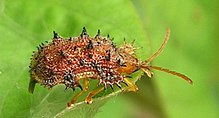Cassidinae
| Cassidinae | |
|---|---|
 |
|
| Platypria sp. | |
| Scientific classification | |
| Kingdom: | Animalia |
| Phylum: | Arthropoda |
| Class: | Insecta |
| Order: | Coleoptera |
| Suborder: | Polyphaga |
| Superfamily: | Chrysomeloidea |
| Family: | Chrysomelidae |
| Subfamily: |
Cassidinae Gyllenhal, 1813 |
| Tribes | |
|
|
The Cassidinae (tortoise and leaf-mining beetles) are a subfamily of the leaf beetles, or Chrysomelidae. It includes both the former subfamily "Hispinae" (leaf-mining beetles), as well as the former more narrowly defined subfamily Cassidinae (familiar as tortoise beetles) which are now split into several tribes that include the tribe Cassidini, and in all include over 125 genera. The traditional separation of the two groups was based essentially on the habitats of the larvae and the general shapes of the adults. The name Cassidinae for the merged subfamily is considered to have priority.
The former grouping of "Hispinae" (sometimes called leaf-mining beetles, or "hispoids") included the tribes Alurnini, Anisoderini, Aproidini, Arescini, Bothryonopini, Callispini, Callohispini, Cephaloleiini, Chalepini, Colaenomendorini, Cryptonychini, Cubispini, Eurispini, Exothispini, Gonophorini, Hispini, Hispoleptini, Hybosispini, Leptispini, Oediopalpini, Oncocephalini, Promecothecini, Prosopodontini, Sceloenoplini and Spilophorini. Most members of these tribes are elongated, slightly flattened beetles with parallel margins, and antennal bases close together on their small heads. They often have punctate elytra and pronotum, sometimes with spines both on and along the edges. The former grouping of Cassidinae (sometimes called tortoise beetles, or "cassidoids") included the tribes Aspidimorphini, Basiprionotini, Cassidini, Delocraniini, Dorynotini, Eugenysini, Goniocheniini, Hemisphaerotini, Mesomphaliini, Notosacanthini, Omocerini and Physonotini. The "cassidoids" have a rounded outline with the edges of the pronotum and elytra spreading out to cover the legs and head. They are often colourful and metallic, with the ability to change the colour (and lost in specimens) which is present in the living tissue below the translucent cuticle. All members of the subfamily have the mouthparts reduced into a cavity in the head capsule, the legs have four segmented tarsi. The hispoids have larvae that are leaf miners, while the cassidoids feed on the plant surfaces, sometimes covering their bodies with faecal shields. Although fecal shields are thought to provide defense, no evidence exists for such a role.Some Cassidini show maternal care of larvae.
The subfamily names Cassidinae and Hispinae are both founded by Gyllenhal in the same 1813 book, but following the Principle of the First Reviser, Chen in this case, priority is given to the name Cassidinae.
Deloyala guttata, mottled tortoise beetle, showing typical shape and patches of metallic coloration
...
Wikipedia
